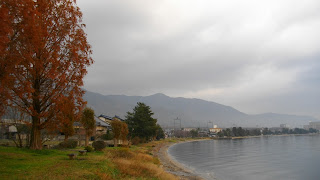One beautiful morning, it was 11am. I, spontaneously, wanted to go somewhere.
I occasionally have this feeling but I always force myself to ignore due to other priorities such as study and work. But I am on holiday (and single!) at the moment so I decided to go with it. :)
Since I am not fond of cold weather, heading west was appeared to be a favorable option.
Departure Point - Kyoto
Seishun Juhachi Kippu (Yourth 18 Ticket)
I bought a Seishun Juhachi Kippu, This is also referred as 'Youth 18 ticket' (Japan-Guide.com, 2011). It contains separable 5 daily unlimited nationwide local train railway tickets, which can be used for any railway lines of Japan Railways (JR).
Japanese Old Train - very tasteful
This ticket is sold only the during holiday periods and cannot be used for express trains such as shinkansen, bullet trains, so there are few limitations but is a very cheap option for travelling around the country (The ticket costs 11,500yen therefore only 2,300yen per day for unlimited travel.). Despite its confusing name, there is no age restriction for the purchase and use of this ticket.
Train interior view
Holding the Youth 18 Ticket, I caught a train heading west.
Encounter with a Madam
At Himeji train station, one madam (obachan) was sitting next to me.
She was also travelling alone using a Youth 18 Ticket. Japanese are very shy people so it is very rear to talk to strangers in normal situation. But as we spend 5 hours on rail sitting next to each other, we talked about many things, such as the criticism of current Japanese politicians, the earthquake, good fishing spots, the difficulty (almost impossibility) of forming successful inter-religious relationship, and tourism hot spots in Japan etc.
With the Youth 18 ticket, train runs very slowly and stops every single station. Time consuming but there is nothing to miss on the way. I have captured many local beauties.
A scenery from the train window
A scenery from the train window
A scenery from the train window
A scenery from the train window
Labour Intensive Japanese Trains
Japanese trains are very labour intensive as for example there are four officers in a four carriage train between Himeji and Hiroshima (about 5 hour journey). It is definitely not cost effective operation from the management point of view (as opposed to the ones in Australia, for example, which normally carries one officer (i.e. train driver) per train but gives you a unique experience of a train journey (and you are not the one paying the wage for them anyway!).
The reason why there are so many officers are because they still doing many things manually and heavily service oriented. For example, the announcement for the coming stations are made manually for every stop. Besides, in addition to informing the next stop they tell us the following information:
1. Local attractions and events information (if any)
2. The manner of mobile use (no talking, mobile need to be switched off on priority seats and area around them.)
3. Possible danger in a train (e.g use of emergency bottom)
4. The side of the door which will open at the next stop
5. Transfer (if any)
6. Apology and details for delay (even 1 minute late)
7. And, finally, appreciation on board
Plus, the officers walk through the carriages every 30 minutes or so, so if you have any inquiries they can help you promptly. Therefore, from my observation, they are busy somehow and that’s why they are so many officers in a train Japan.
Busy officer
Hiroshima and Backpackers Hostel
Finally - Hiroshima
Thinking those things, I am already here in Hiroshima. Hiroshima is one of the two places where an atomic-bomb was dropped upon in the long human history. The city was once completely destroyed and over 200,000 people are killed by just one bomb on 6 August, 1946. Now, Hiroshima has reborn with a Hiroshima Heiwa Koen (Hiroshima Peace Memorial Park) as a peaceful symbol of Japan, being one of the most visited destinations in Japan.
The A-bomb Dorm - Hiroshima Peace Memorial Park
More information on A-bomb Dorm (click the image to enlarge)
Hiroshima Peace Memorial Park
Rest in Peace - Hiroshima Peace Memorial Park
The city itself is very flat and trams are running conveniently across the entire city. Therefore, in my opinion, it is quiet similar to place like Melbourne.
Tram - Hiroshima
Tram Station - Hiroshima
I stayed in a backpackers hostel in Japan for the first time. The place I stayed is called J-Hoppers, probably one of the first backpackers hostel in Japan. This place is not only friendly, clean, comfortable and cheap (I paid only 2,300 yen (26 AUS) for a dorm night) accommodation, they keep entertain tourists in many interesting ways.
J-Hoppers - Entrance
For example, when I was there, local university students were holding a party with the guests at the hostel. I found it was very wise, creating a win-win situation.
The party gives opportunity for the students to learn English (there are many guests from places like Canada and Australia), and guest can have a cheap meal, mingle with local (young) boys and girls and learn about the Japanese culture. And hostel sells beer, which brings additional revenue to the hostel, plus this whole thing would contribute to the healthy globalisation of the community and deepen the understanding between local people and tourists.
So, I am really enjoying my spontaneous acts.
Today's Route
Next, I am slowly heading even east, cannot wait for getting to the next destination.















































